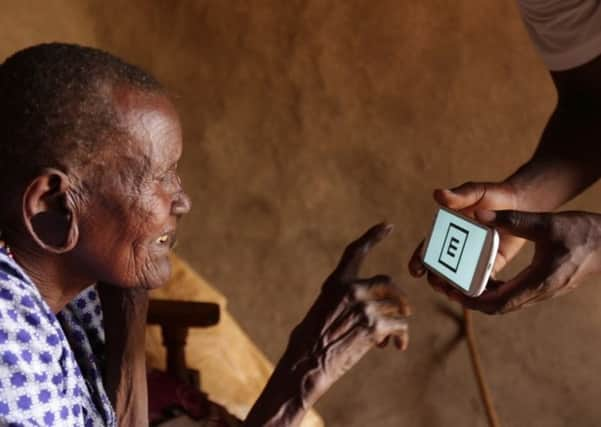Scots app to detect treatable eye conditions


The Portable Eye Examination Kit, or Peek, is as accurate as traditional eye-testing charts, and not dependent on a supply of electricity or cumbersome eye equipment.
Peek was designed and developed by the University of Strathclyde and the NHS Glasgow Centre for Ophthalmic Research, in conjunction with the London School of Hygiene and Tropical Medicine.
Advertisement
Hide AdAdvertisement
Hide AdDr Iain Livingstone, Ophthalmology Specialist Registrar for NHS Greater Glasgow and Clyde, said: “We developed a suite of smartphone-based eye tests to see if we could replace some of the standard equipment being used. We hoped to make it more portable and easier for non-specialists to perform so that ultimately the most high-risk individuals could be reached and treated.”
The idea came about when Dr Andrew Bastawrous, Lecturer in International Eye Health at the London School of Hygiene & Tropical Medicine, and co-founder of Peek, was struggling to transport bulky eye equipment to 100 remote areas in Kenya’s Great Rift Valley. Two-thirds of the locations had no road access or electricity, and carrying more than £100,000 worth of fragile eye equipment, and a team of 15 people in two vans, to be able to carry out high quality measures of eye disease, proved challenging.
“What the team found,” says Dr Livingstone, “was that in the most difficult-to-reach locations we would find lots of people waiting to see us who had been unnecessarily blind from preventable or treatable diseases. Despite the locations having no roads, electricity and often no water, nearly all locations had a good mobile phone signal.” Some 220 million visually impaired people worldwide are estimated to have eye-related diseases which could be cured or prevented. But most live in low-income and developing countries where access to specialist clinics and health-care is limited.
The causes of avoidable blindness, particularly in sub-Saharan Africa, are predominantly cataracts and glaucoma. Dr Bastawrous said: “With most of the world’s blind people living in low-income countries, it is vital we develop new tools to increase early detection and appropriate referral for treatment.
“Mobile phone use is now so widespread that it seemed to be an ideal platform.”
The research, first published in JAMA Ophthalmology, showed results from tests carried out in Kenya on 233 people over 55 in their own homes, and then repeated in eye clinics.
Tests carried out with the Peek app proved to be as reliable as those from standard paper-based charts and illuminated vision boxes in an eye clinic.
Peek consists of a series of apps and a piece of hardware called Peek Retina. One of the apps determines how clearly a person sees.
Advertisement
Hide AdAdvertisement
Hide AdIt has a “tumbling E” on a mobile phone screen, which shows the letter E displayed in four different directions. The patient points in the direction they perceive the arms of the E to be pointing and the tester uses the touch screen to swipe accordingly, translating the gestures from the patient to the phone.